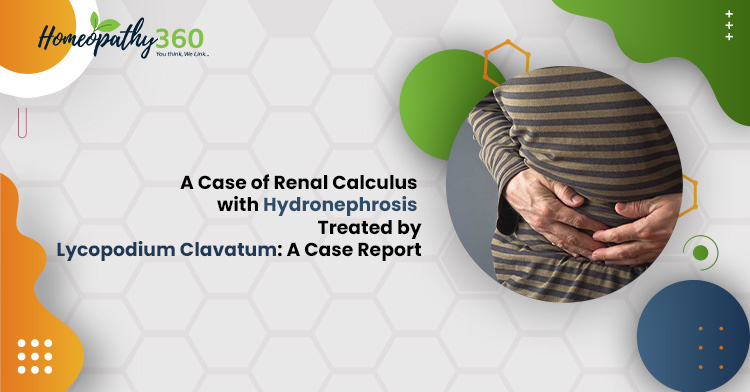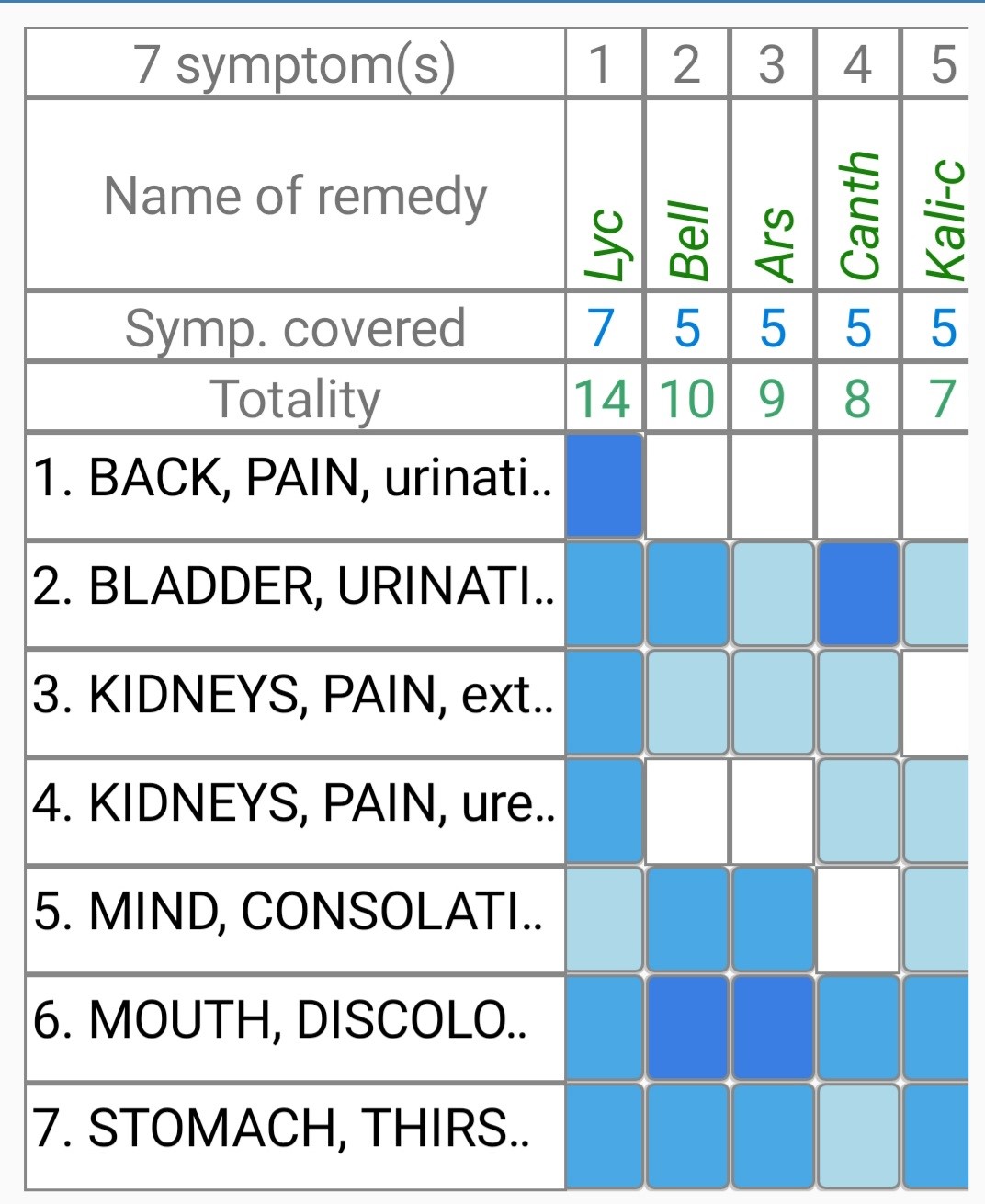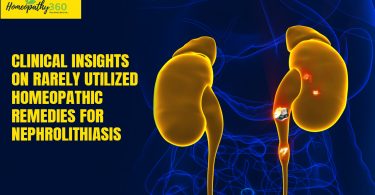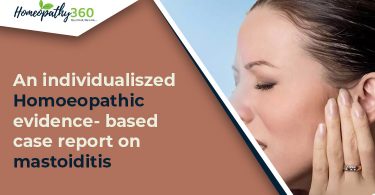
Abstract:
A case of 5 mm calculus, lodged at mid of left ureter with mild hydronephrosis, presented with severe burning and aching in the left lumber region which extends to the bladder. The homoeopathic medicine Lycopodium clavatum is given on the basis of totality of symptoms. The pain is reduced with expulsion of stone within 18 days. The case report shows the potentiality and efficacy of individualised homoeopathic medicine in case of renal calculus.
Keywords:
homoeopathy, individualisation, Lycopodium clavatum, renal calculus.
Abbreviations:
COPD – chronic obstructive pulmonary disease, BD – twice a day, USG – ultrasonography.
Introduction:
Renal calculus or lithiasis is one of the most common diseases of the urinary tract. It occurs more frequently in men than in women. Urinary calculus is a stone-like body composed of urinary salts bound together by a colloid matrix of organic material. The most common symptomatology include pain, difficulty during urination, obstruction leading to hydronephrosis and chronic kidney disease.(1) Homoeopathy plays an important role in such cases due to it’s holistic approach as it deals with patient’s abnormality and treat as a whole.
Case study
Chief complaints:
A 36-year male complained of pain in the left lumber region for 3 months. The pain extended to the bladder for last one weeks. There is burning sensation on the left lumbar region, especially in ureter. The complaints aggravated after taking water and ameliorated by urination.
History of present complaints:
The pain continued for 3 months and took conventional medicine, they suggested surgery for the removal of stone. But he never wanted to opt for surgery. Now, the intensity increased with difficulty in urination and burning sensation while urination. The pain suddenly became severe extended to the bladder. The urinary flow was interrupted and quantity of urine was reduced.
Past history:
He was suffering from typhoid at the age of 20, for which he took conventional medicine.
Family history:
Father suffered from COPD for last 5 years and was under conventional medicine. Mother suffered from osteoarthritis for last 2 years and was taking homoeopathic medicines.
Personal history:
He loved to know new things. His diet was irregular. He had no addictions.
Mental generals and physical generals:
The patient wanted to know new things. No desire for consolation. He was fearless and greedy in nature.
While enquiring his physical aspects, it was found that he had good appetite but was losing his weight. He desired for hot things, had aversion to meat. His tongue was red with no thirst, did not drink even a glass of water. His stools were satisfactory, with dribbling and difficulty in urination.
Diagnosis:
Diagnosis was based on clinical symptoms, physical examination of the patient(1)(2)and ultrasonography (USG) which revealed renal calculus with hydronephrosis (Fig:1)
Analysis and evaluation of symptoms:
| Sl. No. | Symptom type | Symptom | Intensity | Miasmatic analysis(3) |
| 1. | Mental general | No desire for consolation | +++ | Psora, syphilis |
| 2. | Mental general | His tongue was red | ++ | Psora |
| 3. | Mental general | Did not drink water | +++ | Syphilis |
| 4. | Physical general | Pain in kidneys extending to the bladder | +++ | Psora, syphilis |
| 5. | Physical general | Pain especially in the left ureter | +++ | Sycosis |
| 6. | Physical general | Urine came very less, drop by drop | +++ | Psora |
| 7. | Particular symptom | Pain in the back, relieved by urination | +++ | Psora, syphilis |
Repertorial totality:
| Symptoms | Rubric |
| Did not desire for consolation | MIND-CONSOLATION, agg |
| Tongue was red in colour | MOUTH-DISCOLOURATION, tongue, red |
| The patient is thirstless | STOMACH-THIRSTLESS |
| Pain in kidneys extending to the bladder | KIDNEY-PAIN, extending to, bladder |
| Pain especially in the left ureter | KIDNEY-PAIN, Ureters, left side |
| Urine came very less, drop by drop | BLADDER-URINATION, dribbling by drops |
| Pain in the back, relieved by urination | BACK-PAIN, urination, after, amel. |
Repertorisation(4):
See repertorisation sheet
Prescription:
After repertorisation, Lycopodium clavatum possessed highest grade and highest matching of the symptoms. Here, Lycopodium clavatum was selected on the basis of mental as well as physical symptoms of the patient. The patient was greedy in nature and constitution of the patient, in consultation with materia medica(5)(6) and repertorial result. So, Lycopodium clavatum was prescribed for this case.
Prescribed on 30/09/2021
Lycopodium clavatum 200/ 1 dose,early morning mixing with ½ cup of water for 2 days along with placebo every day, two times after eating for 7 days.
The patient was also advised for dietary management like intake of plenty of water, lime juice, avoidance of any kind of spicy or fatty food.
Selection of dose and potency:
As per Organon of Medicine, aphorism 247 5th edition(7), and according to the susceptibility of the patient, the potency was selected. Here the patient was highly susceptible and intensity of the symptoms was also increased as she suffered from that affection since long, hence the case was started with high potency.
Repetition of remedy:
Every well-chosen medicine should be repeated at suitable interval (aphorism 246 5th edition(7) of Organon of Medicine). After initial improvement, if same symptoms reappeared, then one needs to repeat the same medicine.(8)
Follow up:
| Date of visit | Response | Medicine prescribed |
| 04/10/2021 | No changes took place. Dull, aching pain in the left renal region with slight reddish urine | Rubrum-200/ 1 drop BD x 15 days |
| 11/10/2021 | Dull, aching pain in the left renal region was better. | Rubrum -200/ 1 drop BD x 15 days |
| 15 /10/2021 | Dull, aching pain in the left renal region with slight reddish urine. Symptoms reappeared. | Lycopodium clavatum 200/ 1 dose |
| 18/10/2021 | A stone was expelled following an acute colicky pain with slight bleeding | Phytum-200/ 1 drop BD x 15 days |
| 28/10/2021 | Slight burning in the urethra while urinating | Phytum-200/ 1 dose |
| 11/11/2020 | No pain while urinating | Phytum-200/ 1 drop BD x 15 days |
| 25/11/2021 | No calculi on USG report |
Report of the patient:
Conclusion:
In this case presentation, one can see that how a homoeopathic individualised medicine helps to manage a surgical case of renal stone. Homoeopathy possesses a potential scope in management of urolithiasis. Here, with the help of Lycopodium clavatum, complete cure occurs without having any side effects and surgical intervention.
Bibliography:
- Das S, A Concise Text book of Surgery, 2nd ed. Kolkata: Dr. S. Das publishers; 1999
- Nan AK, Undergraduate Surgery, 3rd ed. New Delhi: CBS Publishers and Distributors (P) Ltd.; 2011
- Babu NG, Comprehensive study of Organon, 1st ed. New Delhi: B. Jain publishers (P) Ltd.; 2009
- Kent JT, Repertory of Homoeopathic Materia-Medica, 3rd ed. Kolkata: Rup publication; 2016
- Allen HC, Allen’s Keynote Rearranged and classified, 10th ed. New Delhi: B.Jain publishers (P) Ltd.; 2013
- Boericke W. Boericke’s New Manual of Homoeopathic Materia Medica and Repertory, LPE ed. New Delhi: B. Jain Publishers (P) Ltd.; 2014
- Hahnemann S, Organon Of Medicine, 5th and 6th ed. New Delhi: B. Jain publishers (P) Ltd.; 2016
- Kent JT, Lectures on Homoeopathic Philosophy, LPE ed. New Delhi: B.Jain Publishers (P) Ltd.; 2015
About Author:
- Dr Vivek Kumar Shail, H.O.D, Department of Practice of Medicine, R.B.T.S Govt. Homoeopathic Medical College and Hospital, Muzaffarpur
- Dr Geeta Sharma, BHMS (NIH)







